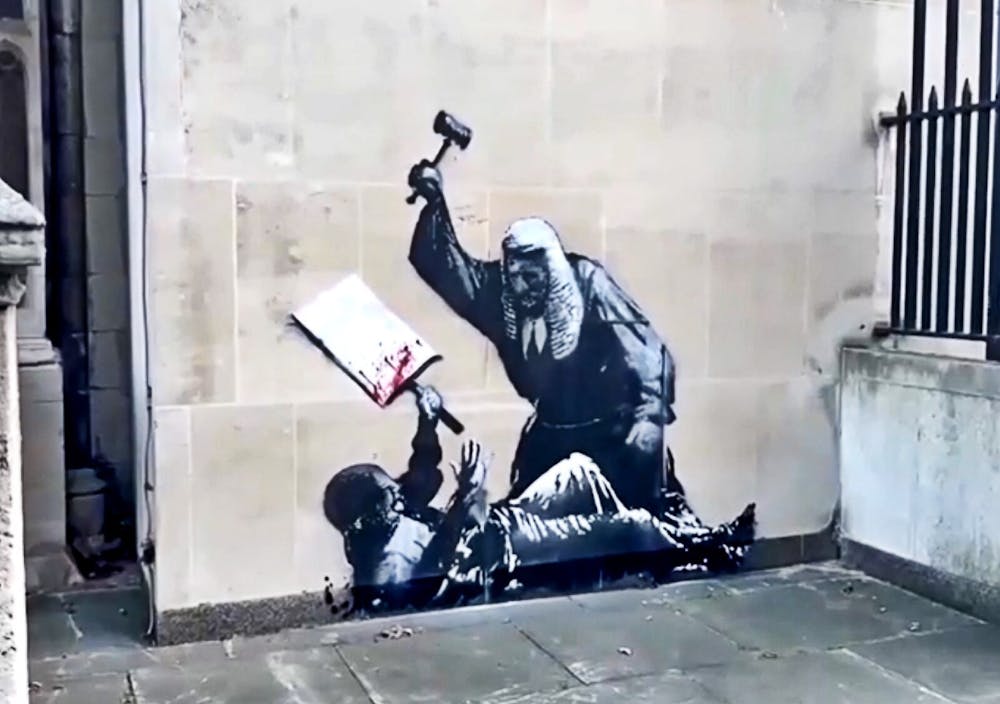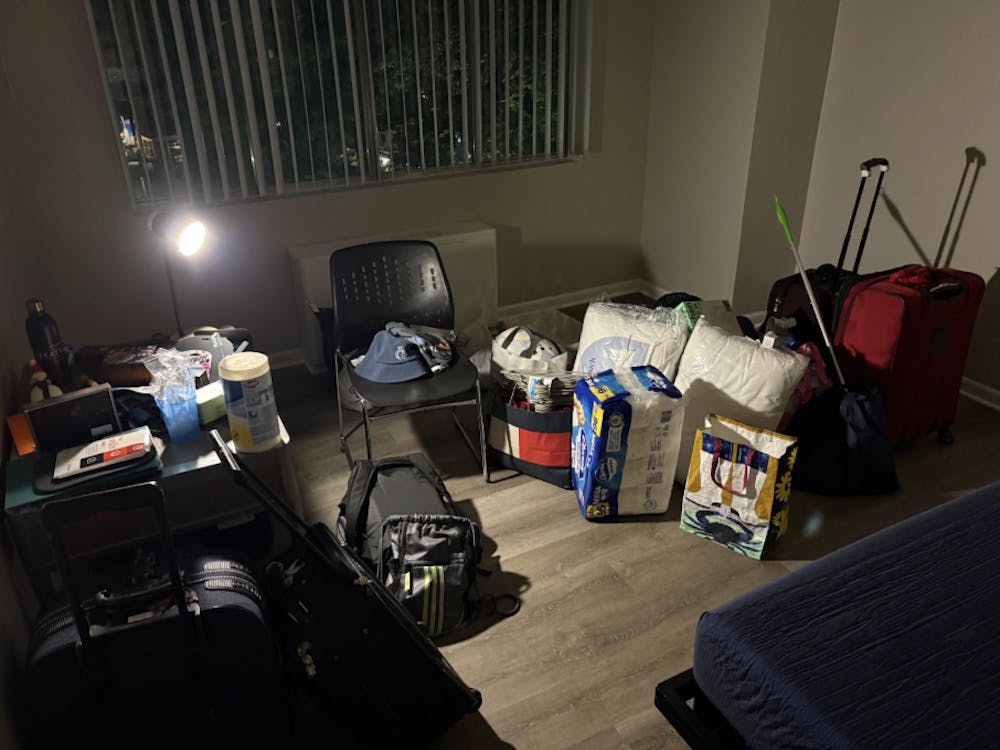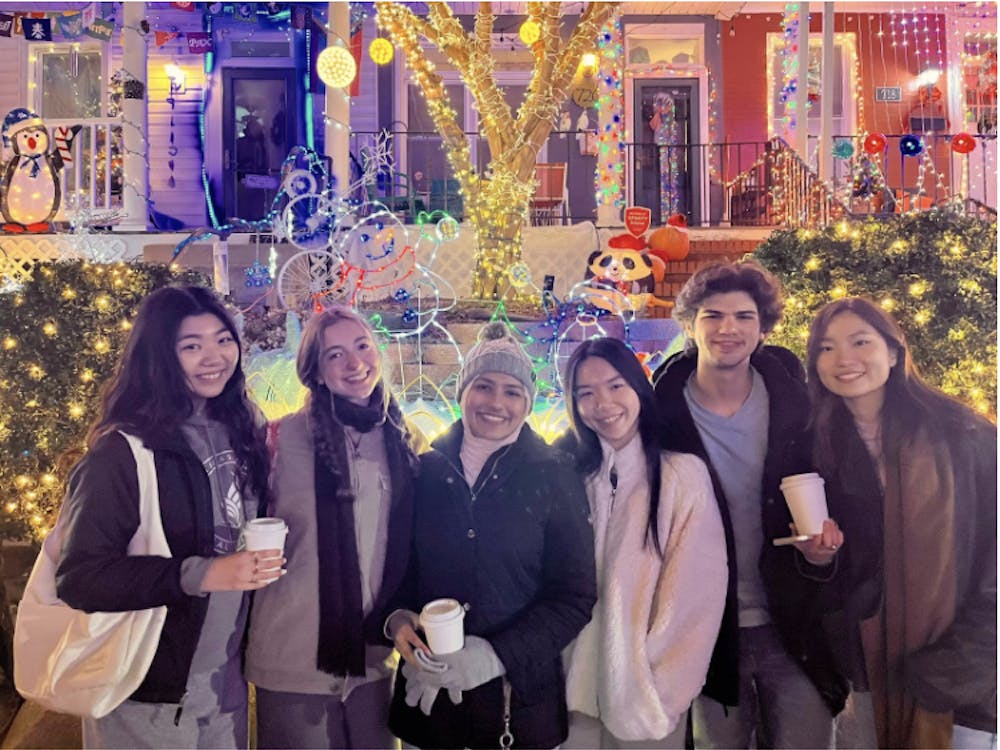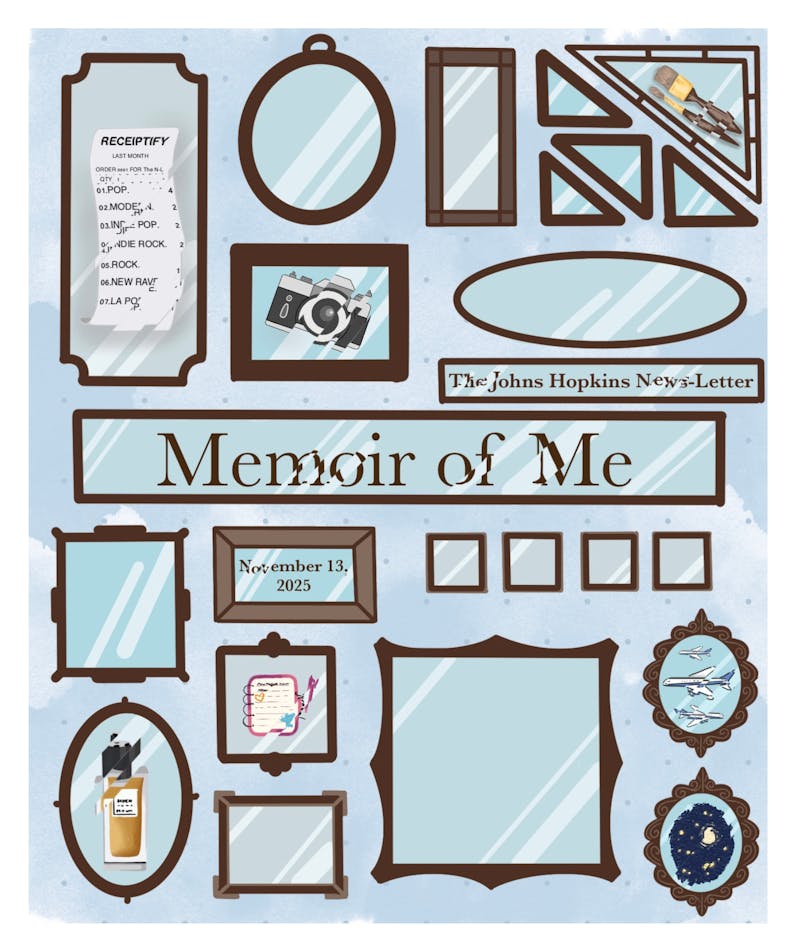From the artist behind the half-shredded “Girl With Balloon” comes a new mural on the walls of the British Royal Courts of Justice. Appearing on Sept. 8, this latest Banksy depicts a judge beating a protestor with a gavel while the protestor defends from the ground, holding a blood-splattered sign.
Perhaps — for better or for worse — the most famous living visual artist, Banksy, teeters on the edge between counter-culture and establishment.
Spray paint, in itself, is both conquering and liberating. Aerosolized spray paint can turn anything into a canvas, resulting in the idea of “tagging.” It’s a kind of claiming, but a claiming that is antithetical to the very idea of possession — as if to say that what was private is now not belonging to the spray painter, but rather to everyone and no one. Together, the nature of spray paint, stencil graffiti and the all too important anonymity that has elevated Banksy to a mythic status evoke clandestinity and “vandalism.” Indeed, his work is often done without permits from the property owners.
On the other hand, the Banksy name is worth millions in the British art market, with dealers sometimes called in to remove and preserve his pieces of city walls to take into the auction room. Art Gallery director John Brandler describes this bluntly.
“His statements are so strong,” Brandler says. “It's brilliant marketing. People are buying by brand.”
The cult of Banksy is inextricably tangled with the establishment, and his subversive efforts and anonymity effortlessly contort into “marketing” tactics.
With regards to these subversive efforts, I subjectively read his political and satirical branding as often falling on the wrong side of obvious. Certainly blatant, but — crediting where credit is due — perhaps incendiary public art has to be.
This latest work is situated in the context of the United Kingdom’s decision to ban Palestine Action, a direct-action group that protests the United Kingdom and global involvement in Israel’s genocide in Gaza and occupation of the West Bank, primarily through destruction of property and interference with weapon manufacturing. As of July 5, the United Kingdom has proscribed Palestine Action as a terrorist group, and supporting the group has become a criminal offense “punishable by up to 14 years in prison.”
Due to his previous criticism of Israel’s actions in the West Bank, many read this Banksy work as support for the Palestine Action movement and its placard-carrying members. Not long after Banksy uploaded an image of the work to his Instagram — the primary method he uses to claim his work — the work was concealed by a metal barrier and has since been scrubbed and covered over.
The “removed” work plays on a Streisand effect. The aesthetic effect of censoring a work protesting censorship is like burning copies of Fahrenheit 451: The remaining silhouette proves conspicuous absence as a greater form of presence. On legal grounds, the building is meant to be preserved as a historical site. Nonetheless, the effect of the removal speaks to a broader trend of censorship. We are supposed to ignore this work, to ignore the censorship faced by Palestine Action and its supporters and even more so the horrific realities faced by Palestinians. What is the significance of this demand for ignorance? What is the worth of attention if we are constantly being told to reserve it?
Anyone keeping up with the news must grapple with hundreds of heartbreaks every day — an absolute bleakness enough to make many apathetic. It is true that we cannot save the day in a superheroic manner. Disillusioned, we often decide to save ourselves the heart-hurt and close the tab. Yet, there is a cognitive dissonance in choosing to turn away. We have a great privilege in being physically and materially removed from these situations. Do we owe them our attention? And if we do, is that all we ought to give?
For French philosopher, mystic and activist Simone Weil, being attentive might just be the most important action a person could take — whether it is even an “action” at all. Weil was a secular saint, a near conservative anarchist and a martyr to the point of death by self-imposed starvation, who, as fellow French philosopher Simone de Beauvoir wrote in her autobiography Memoirs of a Dutiful Daughter, had a “heart that could beat right across the world.”
According to Weil, we’ve been confused about what attention really is. In school, specifically, we think of attention as “a kind of muscular effort” to focus on what is being taught. Attention is a chase — active and eager. Yet, Weil defines attention as the opposite: “negative” and “passive.”
Action centers the self: I do this, I do that. Weil’s attention is the negation of self; it empties oneself of ego to allow the object of our attention to possess us fully. Rather than “going in search of [the most precious gifts],” she instructs that we only obtain them through “waiting.”
As a mystic, Weil’s pure form of cultivated attention is refined to be directed toward the one true thing: God. But she also recognizes its power when directed toward our fellow people:
“The love of our neighbor in all its fullness simply means being able to say to him: ‘What are you going through?’ It is a recognition that the sufferer exists, not only as a unit in a collection, or a specimen from the social category labeled ‘unfortunate,’ but as a man, exactly like us, who was one day stamped with a special mark by affliction.”
This radical empathy may seem simple, yet Weil recognizes it as, quite simply, “a miracle.” It is not always easy to look into the eyes of another person and affirm who they are. It is, in fact, often easier on the consciousness to close up and turn away, even if the object of attention is something as far removed from material tragedy as a Banksy mural. Any reminder is a threat to personal comfort. One would like to shut one’s eyes.
But here we have an ethical question propelling us into moral action. When we are confronted with the sobering reality faced by Palestinians, we first have to answer the question: Do we value these people in themselves and recognize them as human, “as a man exactly like us”? Only after answering can we act, deciding whether or not to look away. Many of us appear to have jumped straight to the action part — that is to say, we have decided to ignore — without truly sitting with the question.
If your answer is “yes,” it only seems reasonable that the first step is to look.





